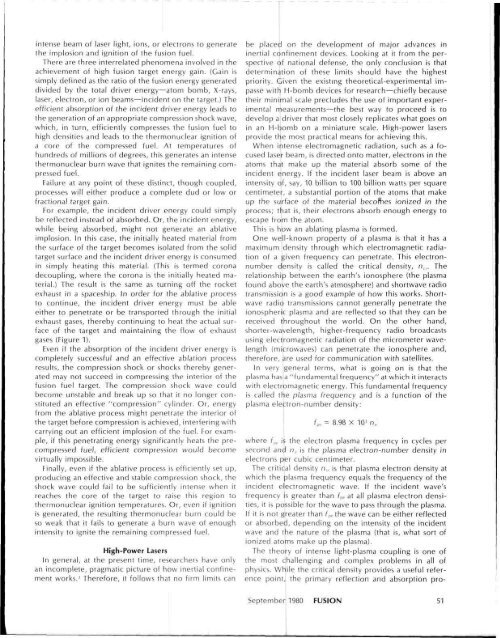fusion energy foundation
fusion energy foundation
fusion energy foundation
- No tags were found...
You also want an ePaper? Increase the reach of your titles
YUMPU automatically turns print PDFs into web optimized ePapers that Google loves.
intense beam of laser light, ions, or electrons to generatethe implosion and ignition of the <strong>fusion</strong> fuel.There are three interrelated phenomena involved in theachievement of high <strong>fusion</strong> target <strong>energy</strong> gain. (Gain issimply defined as the ratio of the <strong>fusion</strong> <strong>energy</strong> generateddivided by the total driver <strong>energy</strong>—atom bomb, X-rays,laser, electron, or ion beams—incident on the target.) Theefficient absorption of the incident driver <strong>energy</strong> leads tothe generation of an appropriate compression shock wave,which, in turn, efficiently compresses the <strong>fusion</strong> fuel tohigh densities and leads to the thermonuclear ignition ofa core of the compressed fuel. At temperatures ofhundreds of millions of degrees, this generates an intensethermonuclear burn wave that ignites the remaining compressedfuel.Failure at any point of these distinct, though coupled,processes will either produce a complete dud or low orfractional target gain.For example, the incident driver <strong>energy</strong> could simplybe reflected instead of absorbed. Or, the incident <strong>energy</strong>,while being absorbed, might not generate an ablativeimplosion. In this case, the initially heated material fromthe surface of the target becomes isolated from the solidtarget surface and the incident driver <strong>energy</strong> is consumedin simply heating this material. (This is termed coronadecoupling, where the corona is the initially heated material.)The result is the same as turning off the rocketexhaust in a spaceship. In order for the ablative processto continue, the incident driver <strong>energy</strong> must be ableeither to penetrate or be transported through the initialexhaust gases, thereby continuing to heat the actual surfaceof the target and maintaining the flow of exhaustgases (Figure 1).Even if the absorption of the incident driver <strong>energy</strong> iscompletely successful and an effective ablation processresults, the compression shock or shocks thereby generatedmay not succeed in compressing the interior of the<strong>fusion</strong> fuel target. The compression shock wave couldbecome unstable and break up so that it no longer constitutedan effective "compression" cylinder. Or, <strong>energy</strong>from the ablative process might penetrate the interior ofthe target before compression is achieved, interfering withcarrying out an efficient implosion of the fuel. For example,if this penetrating <strong>energy</strong> significantly heats the precompressedfuel, efficient compression would becomevirtually impossible.Finally, even if the ablative process is efficiently set up,producing an effective and stable compression shock, theshock wave could fail to be sufficiently intense when itreaches the core of the target to raise this region tothermonuclear ignition temperatures. Or, even if ignitionis generated, the resulting thermonuclear burn could beso weak that it fails to generate a burn wave of enoughintensity to ignite the remaining compressed fuel.High-Power LasersIn general, at the present time, researchers have onlyan incomplete, pragmatic picture of how inertial confinementworks.- 1 Therefore, it follows that no firm limits canbe placed on the development of major advances ininertial confinement devices. Looking at it from the perspectiveof national defense, the only conclusion is thatdetermination of these limits should have the highestpriority. Given the existing theoretical-experimental impassewith H-bomb devices for research—chiefly becausetheir minimal scale precludes the use of important experimentalmeasurements—the best way to proceed is todevelop a driver that most closely replicates what goes onin an H-bomb on a miniature scale. High-power lasersprovide the most practical means for achieving this.When intense electromagnetic radiation, such as a focusedlaser beam, is directed onto matter, electrons in theatoms that make up the material absorb some of theincident <strong>energy</strong>. If the incident laser beam is above anintensity of, say, 10 billion to 100 billion watts per squarecentimeter, a substantial portion of the atoms that makeup the surface of the material becomes ionized in theprocess; that is, their electrons absorb enough <strong>energy</strong> toescape from the atom.This is how an ablating plasma is formed.One well-known property of a plasma is that it has amaximum density through which electromagnetic radiationof a given frequency can penetrate. This electronnumberdensity is called the critical density, n„. Therelationship between the earth's ionosphere (the plasmafound above the earth's atmosphere) and shortwave radiotransmission is a good example of how this works. Shortwaveradio transmissions cannot generally penetrate theionospheric plasma and are reflected so that they can bereceived throughout the world. On the other hand,shorter-wavelength, higher-frequency radio broadcastsusing electromagnetic radiation of the micrometer wavelength(microwaves) can penetrate the ionosphere and,therefore, are used for communication with satellites.In very general terms, what is going on is that theplasma has a "fundamental frequency" at which it interactswith electromagnetic <strong>energy</strong>. This fundamental frequencyis called the plasma frequency and is a function of theplasma electron-number density:f pc = 8.98 X 10 jwhere /,„, is the electron plasma frequency in cycles persecond and n e is the plasma electron-number density inelectrons per cubic centimeter.The critical density r» c , is that plasma electron density atwhich the plasma frequency equals the frequency of theincident electromagnetic wave. If the incident wave'sfrequency is greater than f pe at all plasma electron densities,it is possible for the wave to pass through the plasma.If it is not greater than /> the wave can be either reflectedor absorbed, depending on the intensity of the incidentwave and the nature of the plasma (that is, what sort ofionized atoms make up the plasma).The theory of intense light-plasma coupling is one ofthe most challenging and complex problems in all ofphysics. While the critical density provides a useful referencepoint, the primary reflection and absorption pro-September 1980 FUSION 51n e
















